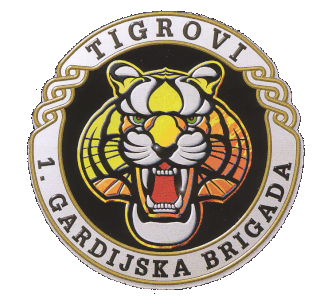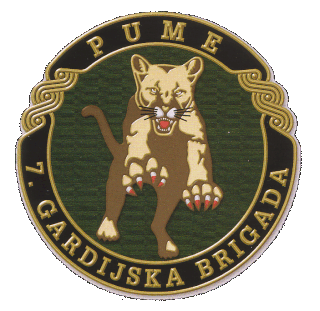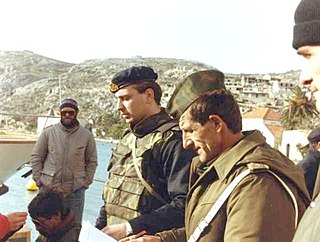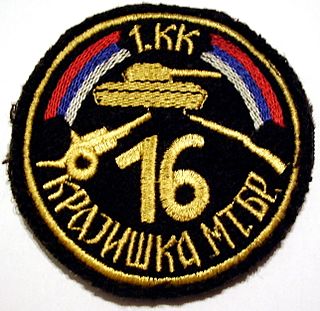
Marko Mesić was a decorated gunnery officer who served in the armies of the Kingdom of Yugoslavia, the Independent State of Croatia, and the SFR Yugoslavia. He is best known for being the final commander of Croatian legionnaires in World War II, serving in the German Wehrmacht on the Eastern Front in the Battle of Stalingrad, and later joining Yugoslav People's Army.

The 1st Mechanized Guard Brigade - named "The Tigers" - was the most elite and best equipped military brigade of the Croatian Army. Its military base and headquarters was in the Croatian capital of Zagreb, origin of most of the brigade's personnel. In 2008, as part of a larger military restructuring, the brigade-sized unit was disbanded and reformed as a battalion of the Motorized Guard Brigade.

The Battle of the Barracks was a series of engagements that occurred in mid-to-late 1991 between the Croatian National Guard and the Croatian police on one side and the Yugoslav People's Army (JNA) on the other. The battle took place around numerous JNA posts in Croatia, starting when Croatian forces blockaded the JNA barracks, weapons storage depots and other facilities. It formally began on 14 September; its objective was to neutralise the JNA positions in ZNG-held territory and to secure arms and ammunition supplies for the poorly equipped ZNG.
The Battle of Zadar was a military engagement between the Yugoslav People's Army, supported by the Croatian Serb Serbian Autonomous Oblast of Krajina, and the Croatian National Guard, supported by the Croatian Police. The battle was fought north and east of the city of Zadar, Croatia, in the second half of September and early October 1991 during the Croatian War of Independence. Although the JNA's initial orders were to lift the Croatian siege of the JNA's barracks in the city and isolate the region of Dalmatia from the rest of Croatia, the orders were amended during the battle to include capturing the Port of Zadar in the city centre. The JNA's advance was supported by the Yugoslav Air Force and Navy.

Operation Grapple was the codeword used to cover UK defence operations in support of the UN peacekeeping missions in the former Yugoslavia ; including the deployment of British forces in Bosnia and Croatia from October 1992 until December 1995 as part of the United Nations Protection Force (UNPROFOR). UNPROFOR would eventually hand over the peacekeeping mission in Bosnia to NATO's Implementation Force (IFOR) in winter 1995. The British participation in the IFOR was called Operation Resolute; the whole NATO mission was called Operation Joint Endeavour. The IFOR mission would last approximately a year, before it transitioned to the follow-on Stabilisation Force in Bosnia and Herzegovina (SFOR).

The 369th (Croatian) Reinforced Infantry Regiment was a regiment of the German Army raised to fight on the Eastern Front during World War II. The regiment was formed in July 1941 by Croatian volunteers from the Independent State of Croatia (NDH), including a Bosnian Muslim battalion. It was commonly referred to as the Croatian Legion. The troops swore a joint oath of allegiance to the Führer, the Poglavnik, the German Reich and the NDH. The unit was sent to the Russian front, where it was attached to the 100th Jäger Division. It was the only non-German unit to participate in the battle of Stalingrad as part of the 6th Army, where it was destroyed. On 31 January 1943, the 800 surviving Croatian legionaries, led by their commander Marko Mesić, surrendered to the Soviet Red Army.

The 7th Corps, was an army corps of the Army of Republic of Bosnia and Herzegovina active during the violent breakup of Yugoslavia and subsequent Bosnian War. It was one of six army corps, the 6th Corps was disbanded on February 26, 1994 and the 8th Corps was never formed.

The 7th Guards Brigade, also known by their nickname Pumas, was a Croatian Ground Army (HV) brigade formed on 23 December 1992 in Varaždin. The brigade was initially formed out of the 5th Battalion of the 1st "Tigers" Brigade and its first commander was Ivan Korade, who led the unit during the War of Independence (1991–95).

The 204th Vukovar Brigade of the Croatian Army was a military unit of the Republic of Croatia that led the defence of the city of Vukovar during the 1991 Battle of Vukovar, in the Croatian War of Independence.

4th Guards Brigade "Spiders" was a brigade of the Croatian Army which took part in the Croatian War of Independence. It was one of the best-known units in the war and it was active until a 2008 reorganization when it was merged into the Motorized Guard Brigade.
Operation Jackal (Serbo-Croatian: Operacija Čagalj, also known as Operation June Dawns, was an offensive of the Bosnian War fought between a combined Croatian Army and Croatian Defence Council army against the Army of Republika Srpska from 7–26 June 1992. The offensive was a Croatian pre-emptive strike against the VRS, a Bosnian Serb military formed in May 1992 from Yugoslav People's Army units that were stationed in Bosnia and Herzegovina. The HV concluded that the JNA offensive operations of April and May 1992, resulting in the capture of Kupres and much of the Neretva River valley south of Mostar, were aimed at capturing or threatening the Croatian Port of Ploče and possibly Split. To counter this threat, the Croatian leadership deployed the HV, under the command of General Janko Bobetko, to the "Southern Front" including the area in which Operation Jackal was to be conducted.

The 1991 Yugoslav campaign in Croatia was a series of engagements between the Yugoslav People's Army (JNA), the Yugoslav Navy and the Yugoslav Air Force, and the Croatian National Guard (ZNG) then the Croatian Army (HV) during the Croatian War of Independence. The JNA was originally deployed in order to preserve Yugoslavia, and the initial plan of the campaign entailed the military occupation of Croatia and the removal of the Croatian leadership elected in 1990. The JNA intervention was the culmination of its involvement in the confiscation of weapons from Croatia's Territorial Defence, and in the Croatian Serb revolt that had begun in August 1990. From that time, the JNA had been frequently deployed to form a buffer zone between the Croatian Serb guerrillas and the ZNG or the Croatian police. In effect, these JNA buffer zones often secured the territorial gains of the insurgents and led to an increasingly hostile relationship between the JNA and Croatia. The JNA campaign plan was amended shortly before the campaign to include the relief of JNA barracks besieged by the ZNG. The besieging and subsequent capture of several JNA facilities allowed Croatia to arm its previously poorly equipped military and to equip and recruit new ethnic Croat conscripts and officers of the Yugoslav People's Army.
The Battle of Logorište was fought east of Duga Resa and south of Karlovac, Croatia, from 4–6 November 1991 during the Croatian War of Independence, between the Croatian National Guard and the Yugoslav People's Army. The ZNG placed the JNA-held Logorište barracks under a blockade as part of the countrywide Battle of the Barracks, which aimed to pin down JNA units isolated in their bases and force them to surrender weapons and ammunition to the ZNG. However, the JNA garrison broke out from the besieged barracks with part of its stored equipment before the ZNG claimed the vacant base. The breakout was supported by JNA units and SAO Krajina units deployed to lift the blockade of the barracks and other JNA garrisons in Karlovac. A battle ensued as the ZNG attempted to contain advancing JNA units, ending with a ceasefire signed in The Hague.
The siege of Varaždin Barracks, also referred to locally as Varaždin's days of war, was the blockade and capture of the Yugoslav People's Army (JNA) barracks and other facilities in and around the city of Varaždin during the Croatian War of Independence. The blockade began on 14 September 1991, quickly escalated into fighting, and ended on 22 September with the surrender of the JNA garrison. It was part of the Battle of the Barracks—an effort by Croatian armed forces to isolate JNA units based at barracks in Croatia, or capture the barracks to provide arms for Croatia's nascent army.
The siege of Bjelovar Barracks, also known by the codename Operation Bilogora, was the blockade and capture of the Yugoslav People's Army (JNA) barracks and other facilities in and around the city of Bjelovar, a part of the JNA 32nd (Varaždin) Corps, during the Croatian War of Independence. A general blockade of the JNA facilities in Croatia was ordered on 14 September 1991, and it continued until 29 September when the JNA garrison was captured by Croatian forces. Its capture occurred one week after the bulk of the 32nd Corps surrendered. It was part of the Battle of the Barracks—an effort by Croatian armed forces to isolate JNA units based at barracks in Croatia, or capture the barracks to provide arms for Croatia's nascent army.
The Battle of Kusonje was a two-day clash fought in the village of Kusonje near the town of Pakrac on 8–9 September 1991, during the Croatian War of Independence. The battle was initiated when a platoon of the Croatian National Guard was ambushed by Croatian Serb forces while conducting a reconnaissance patrol. The ZNG deployed reinforcements to extract the ambushed platoon, but failed to reach them. The surviving members of the platoon held out until they ran out of ammunition and surrendered only to be killed by their captors and buried in a mass grave.

The 104th Guards Airborne Division is a division of the Soviet Airborne Troops and the Russian Airborne Forces. It was originally formed as the 11th Guards Airborne Division during World War II. In December 1944, the 11th Guards Airborne Division became the 104th Guards Rifle Division. On 7 June 1946, the division was renamed the 104th Guards Airborne Division. It was reduced to the 31st Guards Airborne Brigade in May 1998.

The 16th Krajina Motorized Brigade was a motorized unit based in Banja Luka part of the 1st Krajina Corps of the Army of Republika Srpska.
Operation Bura was a joint offensive conducted by the Croatian Defence Council and the Croatian Army on the territories held by the Nevesinje and Bileća brigades of the Army of Republika Srpska during the Bosnian War.

The 154th Brigade - named "The Boškarins of Pazin" - was a Croatian Army guards brigade composed of conscripts from Pazin, Labin, Poreč, Umag, Buje and Buzet. Together with the 1st Home Guard Battalion Pula and the HV 119th Brigade it is one of the military units from Istria employed in the Croatian War of Independence. The unit was active in Otočac, where it was employed in the defense of the city, and participated in the Operation Oluja. The brigade was active from 1991 to 2004.












